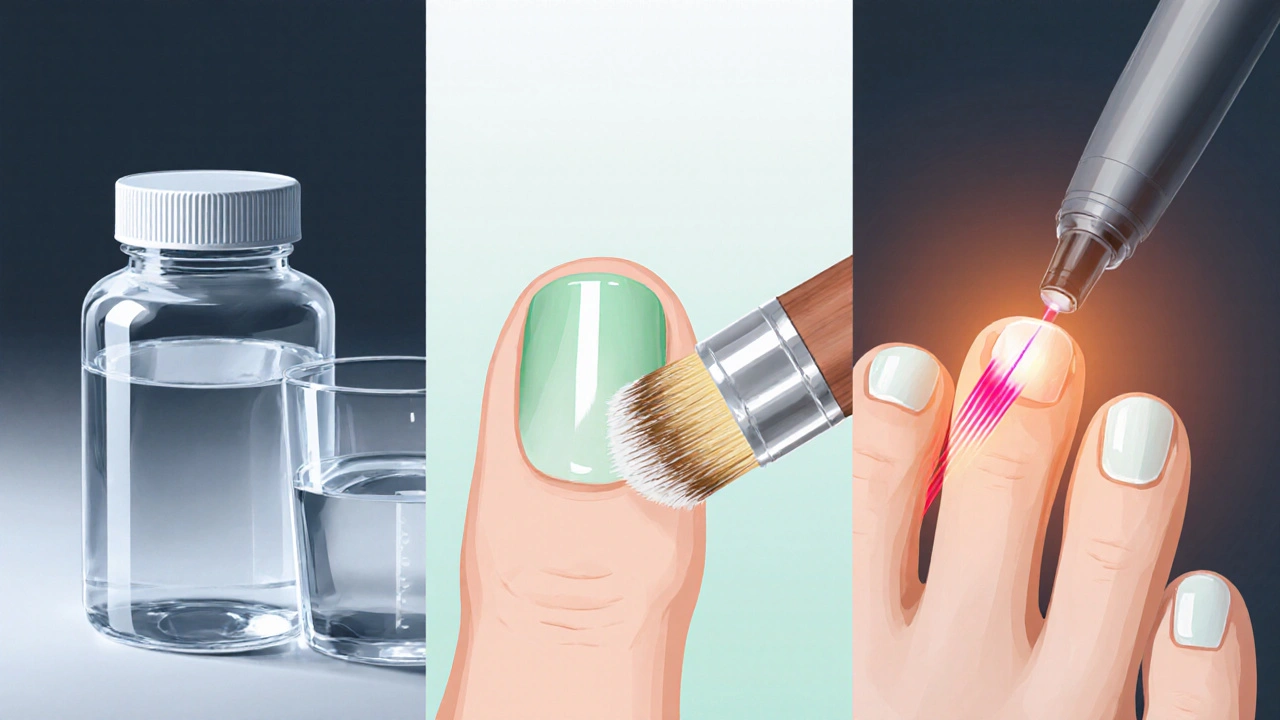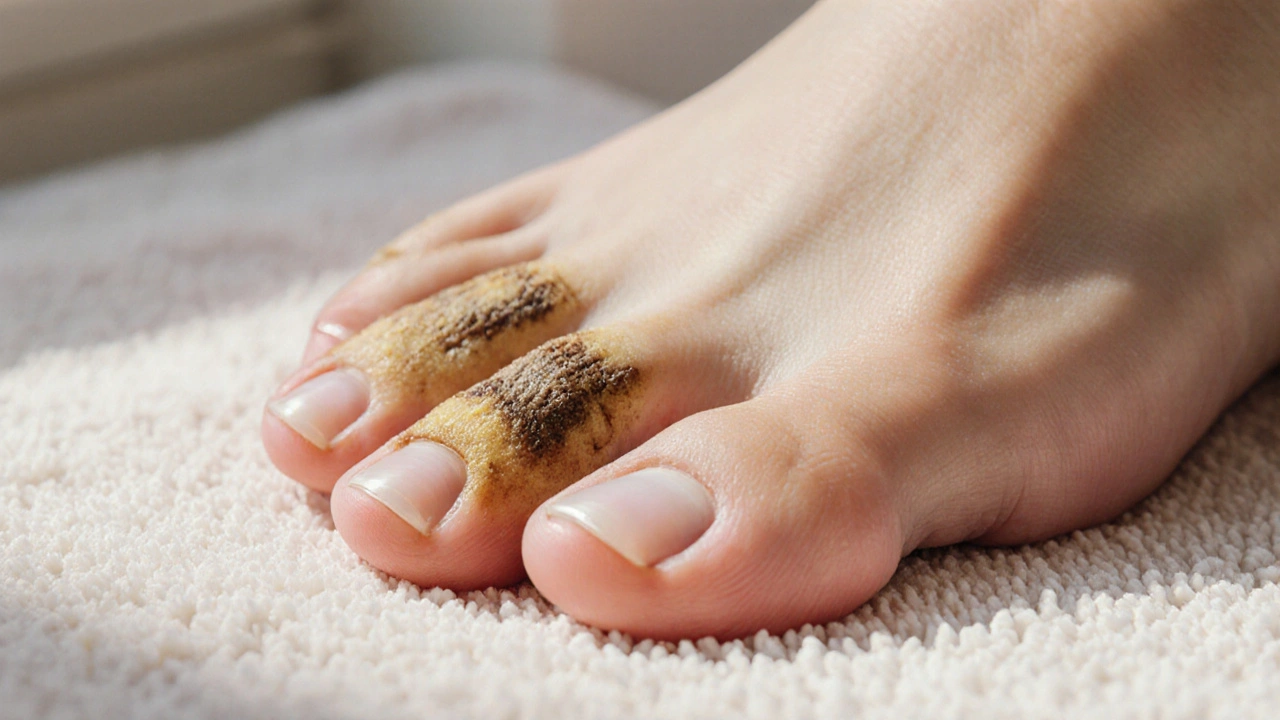Fungal Nail Infection Symptom Checker
Check all symptoms you've noticed in your nails:
Select any risk factors you have:
Your analysis results will appear here after clicking "Analyze Symptoms"
Treatment Options Overview
Oral Medications
Fastest treatment for moderate to severe cases. Requires liver monitoring.
70-80% Cure RateTopical Treatments
Best for early infections or those unable to take oral meds.
30-50% Cure RateLaser Therapy
Drug-free alternative with minimal side effects.
~55% Cure RateQuick Takeaways
- Onychomycosis shows up as thick, discolored nails and may spread if ignored.
- Common culprits are dermatophytes, yeasts (Candida) and molds.
- Oral antifungals work fastest, but topical creams work for mild cases.
- Laser therapy is an emerging, drug‑free option for stubborn infections.
- Good foot hygiene and breathable shoes lower your risk dramatically.
When you notice a nail that’s turning yellow, feels gritty, or is separating from the skin, you might be dealing with a fungal nail infection. This guide walks you through what it is, how to spot it early, and which treatment routes actually clear the problem without wasting months on guesswork.
What exactly is a fungal nail infection?
Onychomycosis is a persistent infection of the nail plate caused by fungi that thrive in warm, moist environments. It affects both toenails and fingernails, but toes are hit far more often because they’re hidden in shoes.
Typical signs you shouldn’t ignore
The infection progresses slowly, so many people mistake early changes for simple nail wear. Below is a symptom checklist that helps you pinpoint a problem before it spreads.
- Yellow, brown, or white streaks along the nail surface.
- Thickening of the nail that makes it feel rough or crumbly.
- Distorted nail shape - the tip may become ragged or lift away (onycholysis).
- A foul, musty odor, especially after removing socks.
- Pain or tenderness when pressure is applied, often after long walks.
If you see three or more of these signs for more than a month, it’s time to investigate further.
Who’s most likely to get onychomycosis?
Anyone can develop the condition, but certain risk factors raise the odds dramatically.
- Age over 40 - nail growth slows, making it harder to shed infected tissue.
- Frequent exposure to damp areas (swimming pools, communal showers).
- Diabetes or peripheral vascular disease - reduced circulation hampers immune response.
- Wearing tight, non‑breathable shoes for long periods.
- Existing athlete’s foot or other skin fungal infections.
How doctors confirm the diagnosis
Because nail changes can mimic psoriasis, trauma, or eczema, a professional assessment is crucial.
A typical visit includes:
- Visual inspection by a Dermatologist a medical specialist in skin, hair, and nail disorders or a podiatrist.
- Scraping or clipping the affected nail for a laboratory test (KOH prep, culture, or PCR) to identify the exact fungus.
- In ambiguous cases, a nail matrix biopsy may be ordered to rule out malignancy.

Treatment options - what really works?
The choice of therapy hinges on infection severity, the fungus type, and the patient’s health profile. Below is a rundown of the most evidence‑backed methods.
Oral antifungal medications
For moderate to severe cases, pills are the gold standard because they reach the nail bed through the bloodstream.
- Terbinafine an allylamine antifungal taken once daily for 6-12 weeks (toenails) or 4-6 weeks (fingernails). Cure rates hover around 70‑80%.
- Itraconazole - administered as a pulse (one week on, three weeks off) for 3‑4 cycles. Useful when drug interactions with terbinafine are a concern.
Both drugs require liver‑function monitoring before and during treatment.
Topical antifungal creams and lacquers
Topical agents stay on the nail surface, so they work best for early, shallow infections or for people who can’t take oral meds.
- Ciclopirox a 8% lacquer applied daily to the cleaned nail for up to 48 weeks. Success rates are 30‑40%.
- Efinaconazole 10% solution - applied twice daily, penetrates the nail better than older lacquers, with cure rates near 50%.
Topicals demand strict adherence; missed applications quickly undo progress.
Laser and light‑based therapies
These are drug‑free alternatives that use focused light to destroy fungal cells.
- Nd:YAG 1064nm laser - multiple sessions (usually 4‑6) spaced a few weeks apart. Studies in 2023-2024 report clearance in roughly 55% of participants.
- Photodynamic therapy - applies a photosensitizer followed by blue light. Still experimental, but early data show promise for resistant molds.
Laser treatment is pricey and not covered by most insurers, yet it avoids systemic side effects.
Adjunct home remedies
While not a substitute for medical therapy, certain over‑the‑counter agents can boost outcomes.
- Tea tree oil - 20% dilution applied twice daily has modest antifungal activity.
- Vicks VapoRub (camphor, eucalyptus) - a 2022 trial found a 30% improvement over no treatment when used nightly for 48 weeks.
Use these only after discussing with your clinician, especially if you have diabetes or poor circulation.
Choosing the right therapy - a quick comparison
| Aspect | Oral (e.g., Terbinafine) | Topical (e.g., Ciclopirox) | Laser |
|---|---|---|---|
| Typical duration | 6-12weeks (toenail) | Up to 48weeks | 4-6 sessions over 2‑3months |
| Cure rate (clinical trials) | 70‑80% | 30‑50% | ~55% |
| Side‑effects | Liver enzyme changes, GI upset | Local irritation, discoloration | Transient warmth, mild pain |
| Cost (US$) | 150‑300 total | 200‑400 total | 600‑1200 total |
| Insurance coverage | Often covered | Rarely covered | Usually not covered |
When the infection is extensive or involves the nail matrix, oral medication is usually the fastest path to clearance. For thin, early‑stage disease, a topical lacquer may spare you from systemic exposure. Laser shines for people who cannot take pills or have recurrent infections despite medication.
Prevention - stop fungal nail infections before they start
Even after you clear an infection, the fungus loves to come back. Here are habits that dramatically lower recurrence.
- Keep feet dry: change socks at least once a day, use moisture‑wicking liners.
- Choose breathable footwear (leather or mesh) and rotate shoes every 24hours.
- Disinfect nail tools with 70% isopropyl alcohol after each use.
- Avoid walking barefoot in communal showers; wear flip‑flops.
- Trim nails straight across, file sharp edges, and avoid aggressive cuticle removal.
When to see a specialist
If you notice any of the following, book an appointment promptly:
- Rapid nail change within weeks. \n
- Severe pain, swelling, or drainage.
- Diabetes, peripheral neuropathy, or immunosuppression - infections can spread faster.
- Failure of over‑the‑counter treatments after 2‑3months.
A Dermatologist a physician trained to diagnose and treat skin, hair, and nail disorders can order cultures, prescribe oral terbinafine, or arrange laser therapy.
Bottom line
Fungal nail infections are stubborn, but they’re not untreatable. By catching the signs early, confirming the culprit with a proper lab test, and picking a therapy that matches the severity, most people achieve a clean, healthy nail within a few months. Pair treatment with solid hygiene habits, and you’ll keep your nails fungus‑free for good.
Frequently Asked Questions
Can I treat nail fungus at home without a prescription?
Over‑the‑counter creams and natural oils may help mild cases, but they rarely clear an infection that’s already thickened. Most dermatologists recommend a prescription oral antifungal for reliable results.
How long will it take for a clear nail to grow back?
Toenails grow about 1mm per month, so a full regrowth can take 12‑18months after the fungus is eliminated. Fingernails heal faster-roughly 3‑6months.
Are there any side‑effects I should worry about with oral terbinafine?
The most common issues are mild gastrointestinal upset and occasional liver‑enzyme elevation. Baseline liver tests and a follow‑up after four weeks usually catch any problems early.
Is laser therapy safe for pregnant women?
Current research indicates no systemic absorption, making it a low‑risk option. However, most providers still recommend waiting until after pregnancy as a precaution.
Can nail fungus spread to other parts of my body?
Yes. The same fungus can cause athlete’s foot or skin infections, especially in warm, damp areas. Treating the nail and maintaining good hygiene reduces cross‑contamination.

Joery van Druten
October 3, 2025 AT 05:15Spotting onychomycosis early can save you months of hassle. The yellow streaks and thickening are classic red flags. If you notice a musty odor, that’s another clue the fungus is thriving. Keep an eye on the nail shape – lifting or ragged edges aren’t normal. A quick visit to a dermatologist can confirm the diagnosis before it spreads.
Melissa Luisman
October 5, 2025 AT 12:48Stop ignoring the thick nails; they’re screaming for treatment.
Alice Witland
October 7, 2025 AT 20:21Oh great, another nail looking like a piece of old toast – just what we needed. The onlookers will surely appreciate the new “rustic” vibe. Of course, the fungus is probably just trying to make a fashion statement. But if you prefer actual health over avant‑garde décor, a proper check‑up is the way to go.
Chris Wiseman
October 10, 2025 AT 03:55When it comes to nail fungus, the devil truly resides in the details.
Most people shrug off a yellowish hue, assuming it’s merely a cosmetic quirk.
Yet that discoloration signals keratin being invaded by resilient dermatophytes.
The pathogen burrows under the nail plate, feeding on the dead tissue.
As it proliferates, the nail thickens, becoming rough and crumbly.
This structural change not only looks unsightly but also hinders normal nail growth.
Compounding the problem, a foul odor can emerge, a byproduct of microbial metabolism.
If you’re diabetic or have poor circulation, the stakes rise dramatically.
Delayed treatment can lead to secondary bacterial infections, sometimes requiring hospitalization.
Laboratory confirmation, via KOH prep or culture, removes the guesswork.
Oral terbinafine boasts cure rates up to eighty percent, but mandates liver monitoring.
Topical agents like efinaconazole may work for superficial cases, though adherence is key.
Laser therapy offers a drug‑free route, yet its cost remains prohibitive for many.
Regardless of modality, consistency over weeks is non‑negotiable; half‑hearted applications rarely succeed.
In short, recognize the signs early, get a proper diagnosis, and commit to a full course – your nails will thank you.
alan garcia petra
October 12, 2025 AT 11:28Hey, don’t let those funky nails get you down. A little foot hygiene and a quick doc visit can turn things around fast. You’ve got this!
Allan Jovero
October 14, 2025 AT 19:01In accordance with current clinical guidelines, oral terbinafine remains the first‑line therapy for extensive onychomycosis. Its pharmacokinetic profile ensures adequate nail bed penetration, thereby enhancing eradication rates. Nevertheless, baseline hepatic function testing is indispensable prior to initiation. Should contraindications arise, alternative agents such as itraconazole pulses merit consideration.
Andy V
October 17, 2025 AT 02:35Your points are well taken; however, the cost factor deserves more scrutiny.
Many patients cannot shoulder the expense of prolonged oral therapy without insurance support.
Tammie Sinnott
October 19, 2025 AT 10:08Wow, this is a nail‑biter in more ways than one! 🌟 The drama of thick, yellow claws turning into a sleek, healthy set is totally worth the hustle. Keep the optimism flowing, and those nails will sparkle soon enough.
Michelle Wigdorovitz
October 21, 2025 AT 17:41Honestly, I tried that tea‑tree oil hack and saw a tiny bit of improvement, but staying consistent was the real challenge. Pairing it with proper shoe ventilation made a bigger difference than I expected. If you’re battling stubborn spots, give it a solid month and see how it goes.
Arianne Gatchalian
October 24, 2025 AT 01:15I totally agree, a balanced routine of hygiene and medical advice is the sweet spot. It’s comforting to know you’re not alone in navigating this.
Aly Neumeister
October 26, 2025 AT 07:48Look; this topic-is it?-pretty dense! Yet, clarity is key: diagnose early, treat properly, prevent recurrence.